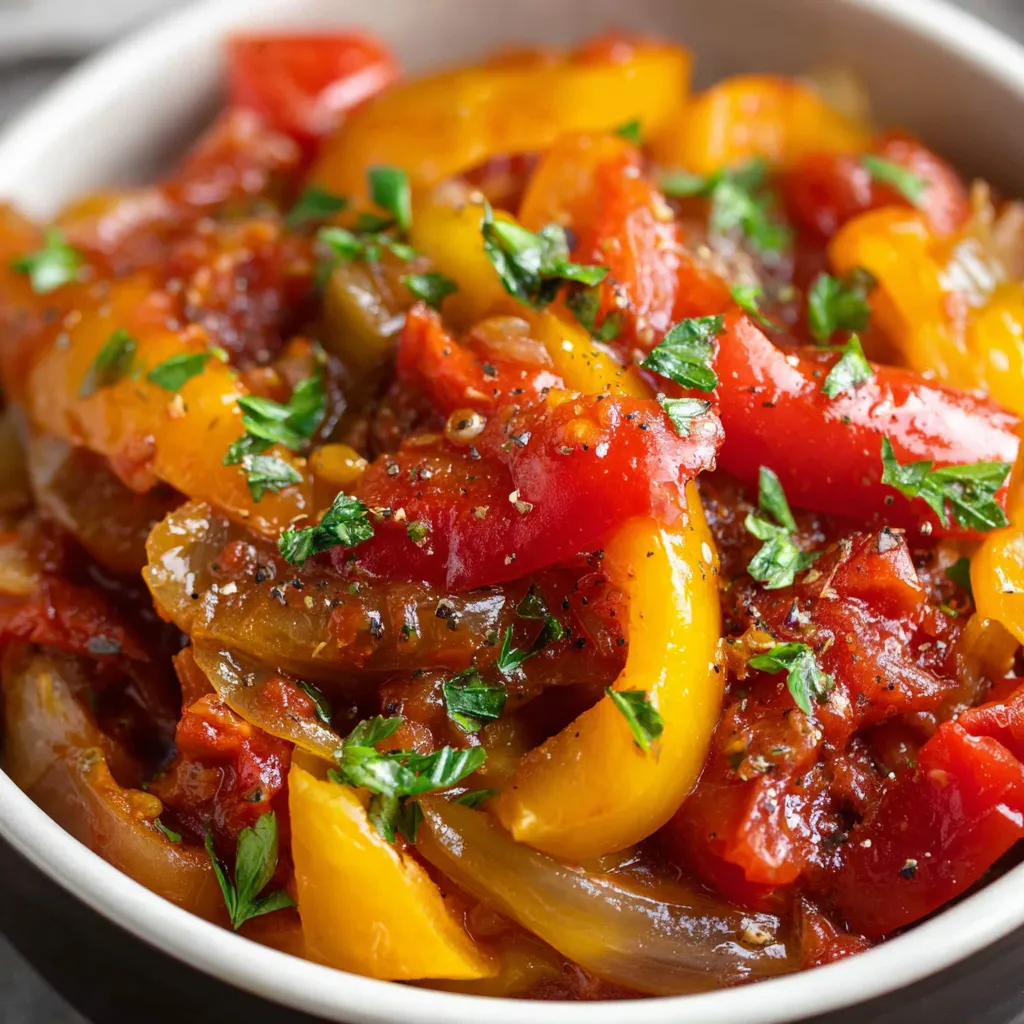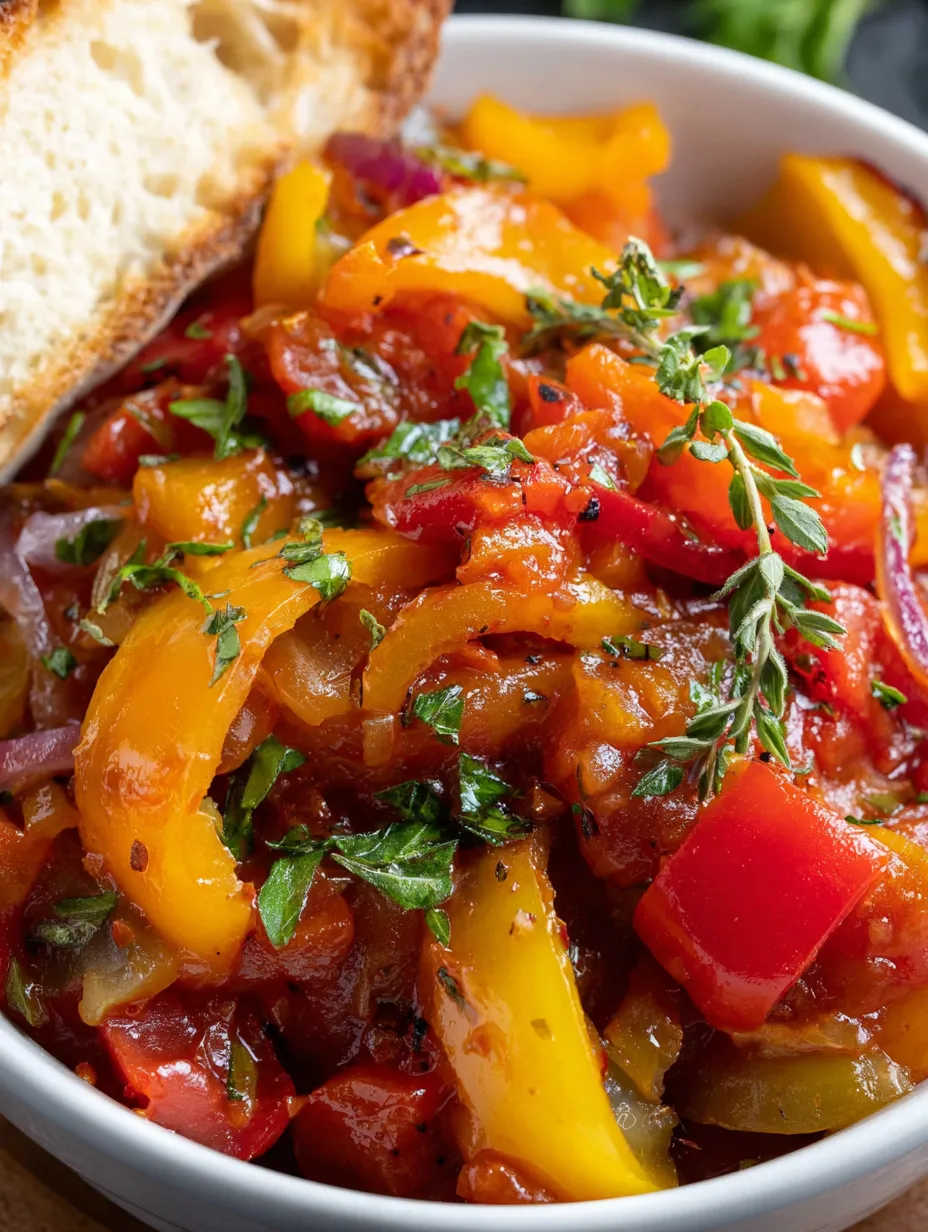 Save
Save
This vibrant Italian peperonata is my go-to when I crave something hearty yet fresh. It brings together tender bell peppers, onions, and juicy tomatoes for a dish that is both comforting and perfect year-round. I make it when I want the kitchen to fill with sweet aromas and evoke memories of my Nonna’s rustic table.
I started making this to use up a big market haul of peppers and fell in love with how it flavors everything it touches from toast to pasta.
Ingredients
- Large red yellow or orange bell peppers: add bold color and mellow sweetness thick skinned peppers with glossy flesh work best
- Onions: bring gentle sweetness and become meltingly soft in the stew look for firm bulbs with papery skins
- Fresh garlic: deepens the savory notes plump unblemished cloves are the best option
- Large ripe tomatoes: give the sauce a summery richness or use quality canned tomatoes if fresh are not flavorful
- Olive oil: forms the backbone of the dish always choose extra virgin for deeper flavor
- Salt and black pepper: lift all the flavors use sea salt if you have it
- Red wine vinegar: adds subtle brightness optional
- Fresh basil or parsley: for a herbal pop choose tender unbruised leaves
Step-by-Step Instructions
- Prep the Vegetables:
- Wash bell peppers and slice into long thin strips for even cooking. Peel onions then slice into thin half moons. Smash peel and finely chop garlic for maximum aroma.
- Build the Flavor Base:
- Pour olive oil into a roomy skillet and set over medium heat. Slide in sliced onions and cook them very gently until they look golden and soft around seven minutes. Add garlic and let it become fragrant for another minute.
- Sweat the Peppers:
- Stir bell peppers into the skillet making sure each strip is slicked with oil. Cook uncovered and stir now and then until peppers begin to collapse and glisten after about ten minutes.
- Simmer with Tomatoes:
- Tip in chopped tomatoes with all their juices. Season with salt and pepper to taste. Stir, then tuck a lid over the pan and drop heat to low. Let the mixture bubble gently until everything melds together and creates a silky stew about twenty five to thirty minutes. Stir every so often to prevent sticking.
- Finishing Touches:
- Take off the lid and taste for seasoning. Add another pinch of salt or a splash of red wine vinegar if you enjoy a tangy finish. Scatter chopped fresh herbs over the top just before serving.

I am especially fond of the way fresh basil transforms the dish. Just chopping it at the last second releases an aroma that reminds me of picking herbs in my grandmother’s summer garden with the warm soil underfoot.
Storage Tips
Let any leftover peperonata cool to room temperature before covering and refrigerating. It will keep in a sealed container for up to four days. The flavors continue to develop so it is even tastier on day two. Reheat gently or serve straight from the fridge as a chilled salad.
Ingredient Substitutions
If bell peppers are not available you can use sweet Italian frying peppers or even a mix with poblano for a touch of heat. Out of fresh tomatoes Choose whole canned tomatoes that are unsalted and crush them by hand. Shallots can replace onions for a more delicate touch.
Serving Suggestions
Serve warm piled on grilled sourdough or alongside a roast as a side. It is fantastic on pasta or couscous with a drizzle of extra oil. I sometimes spoon it over creamy polenta for a cozy weeknight meal.

A Dish with History
Peperonata is a beloved staple in southern Italian kitchens where summer vegetables are treasured in countless homey dishes. Each region and family has subtle differences. It has been on my family table for generations particularly at gatherings when there is no rush and everyone can pass around second helpings.
Recipe FAQs
- → What type of peppers work best in peperonata?
Sweet bell peppers in red, yellow, or orange varieties create the best flavor and color for peperonata.
- → Can I use canned tomatoes instead of fresh?
Yes, canned chopped tomatoes make a convenient substitute when fresh tomatoes aren't available.
- → Should the dish be served hot or cold?
Peperonata can be enjoyed warm or at room temperature, depending on your preference or use as a topping.
- → What are good pairings for peperonata?
It goes well with toasted bread, grilled meats, fish, or as part of an antipasto spread.
- → How do I add extra flavor?
Try finishing with a splash of red wine vinegar and sprinkling fresh basil or parsley before serving.
